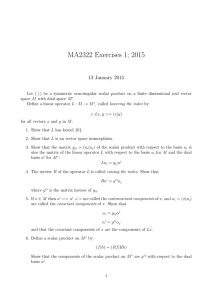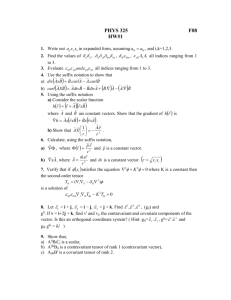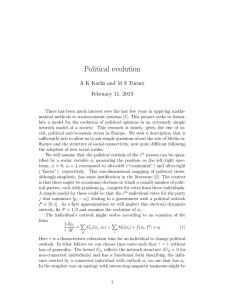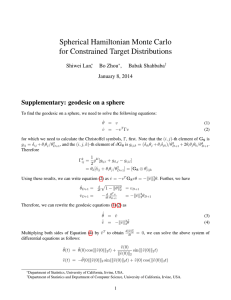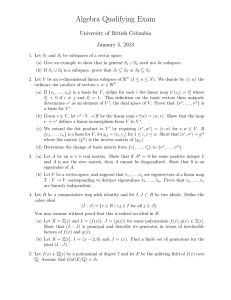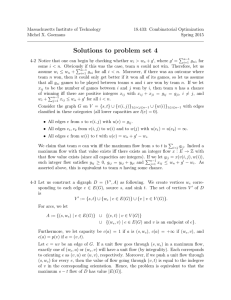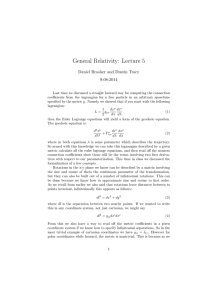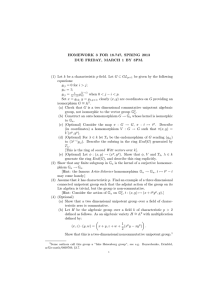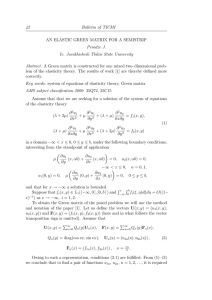Asymptotic Consensus Solutions in Non-Linear Delayed Distributed
advertisement
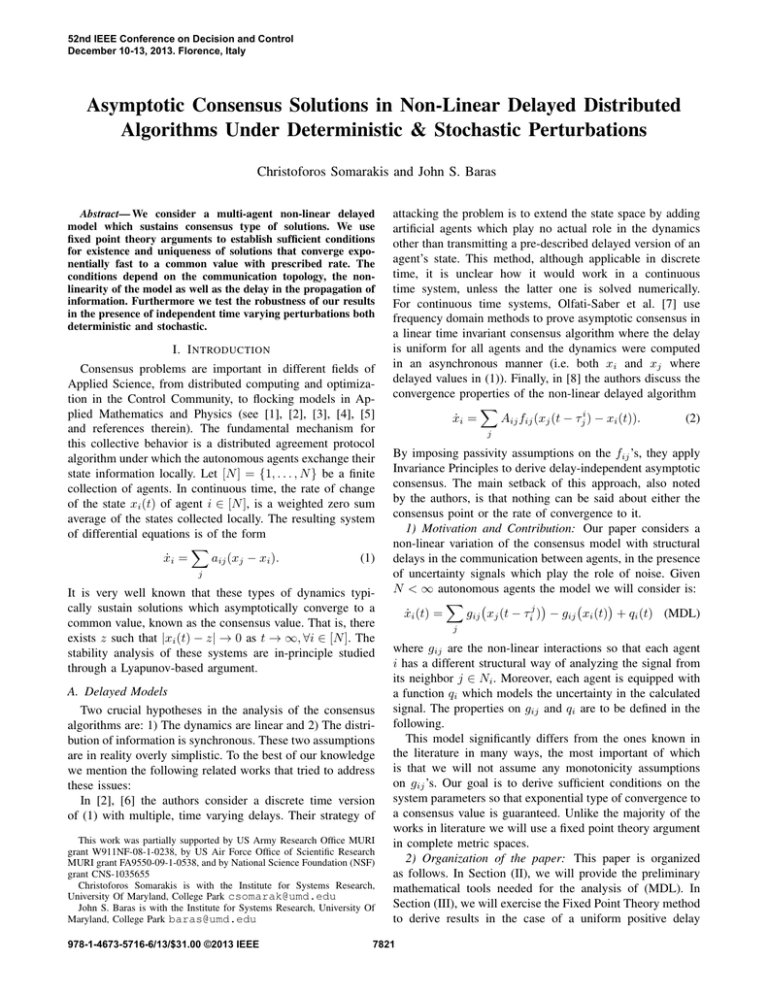
52nd IEEE Conference on Decision and Control
December 10-13, 2013. Florence, Italy
Asymptotic Consensus Solutions in Non-Linear Delayed Distributed
Algorithms Under Deterministic & Stochastic Perturbations
Christoforos Somarakis and John S. Baras
Abstract— We consider a multi-agent non-linear delayed
model which sustains consensus type of solutions. We use
fixed point theory arguments to establish sufficient conditions
for existence and uniqueness of solutions that converge exponentially fast to a common value with prescribed rate. The
conditions depend on the communication topology, the nonlinearity of the model as well as the delay in the propagation of
information. Furthermore we test the robustness of our results
in the presence of independent time varying perturbations both
deterministic and stochastic.
I. I NTRODUCTION
Consensus problems are important in different fields of
Applied Science, from distributed computing and optimization in the Control Community, to flocking models in Applied Mathematics and Physics (see [1], [2], [3], [4], [5]
and references therein). The fundamental mechanism for
this collective behavior is a distributed agreement protocol
algorithm under which the autonomous agents exchange their
state information locally. Let [N ] = {1, . . . , N } be a finite
collection of agents. In continuous time, the rate of change
of the state xi (t) of agent i ∈ [N ], is a weighted zero sum
average of the states collected locally. The resulting system
of differential equations is of the form
X
ẋi =
aij (xj − xi ).
(1)
j
It is very well known that these types of dynamics typically sustain solutions which asymptotically converge to a
common value, known as the consensus value. That is, there
exists z such that |xi (t) − z| → 0 as t → ∞, ∀i ∈ [N ]. The
stability analysis of these systems are in-principle studied
through a Lyapunov-based argument.
A. Delayed Models
Two crucial hypotheses in the analysis of the consensus
algorithms are: 1) The dynamics are linear and 2) The distribution of information is synchronous. These two assumptions
are in reality overly simplistic. To the best of our knowledge
we mention the following related works that tried to address
these issues:
In [2], [6] the authors consider a discrete time version
of (1) with multiple, time varying delays. Their strategy of
This work was partially supported by US Army Research Office MURI
grant W911NF-08-1-0238, by US Air Force Office of Scientific Research
MURI grant FA9550-09-1-0538, and by National Science Foundation (NSF)
grant CNS-1035655
Christoforos Somarakis is with the Institute for Systems Research,
University Of Maryland, College Park csomarak@umd.edu
John S. Baras is with the Institute for Systems Research, University Of
Maryland, College Park baras@umd.edu
978-1-4673-5716-6/13/$31.00 ©2013 IEEE
attacking the problem is to extend the state space by adding
artificial agents which play no actual role in the dynamics
other than transmitting a pre-described delayed version of an
agent’s state. This method, although applicable in discrete
time, it is unclear how it would work in a continuous
time system, unless the latter one is solved numerically.
For continuous time systems, Olfati-Saber et al. [7] use
frequency domain methods to prove asymptotic consensus in
a linear time invariant consensus algorithm where the delay
is uniform for all agents and the dynamics were computed
in an asynchronous manner (i.e. both xi and xj where
delayed values in (1)). Finally, in [8] the authors discuss the
convergence properties of the non-linear delayed algorithm
X
ẋi =
Aij fij (xj (t − τji ) − xi (t)).
(2)
j
By imposing passivity assumptions on the fij ’s, they apply
Invariance Principles to derive delay-independent asymptotic
consensus. The main setback of this approach, also noted
by the authors, is that nothing can be said about either the
consensus point or the rate of convergence to it.
1) Motivation and Contribution: Our paper considers a
non-linear variation of the consensus model with structural
delays in the communication between agents, in the presence
of uncertainty signals which play the role of noise. Given
N < ∞ autonomous agents the model we will consider is:
X
ẋi (t) =
gij xj (t − τij ) − gij xi (t) + qi (t) (MDL)
j
where gij are the non-linear interactions so that each agent
i has a different structural way of analyzing the signal from
its neighbor j ∈ Ni . Moreover, each agent is equipped with
a function qi which models the uncertainty in the calculated
signal. The properties on gij and qi are to be defined in the
following.
This model significantly differs from the ones known in
the literature in many ways, the most important of which
is that we will not assume any monotonicity assumptions
on gij ’s. Our goal is to derive sufficient conditions on the
system parameters so that exponential type of convergence to
a consensus value is guaranteed. Unlike the majority of the
works in literature we will use a fixed point theory argument
in complete metric spaces.
2) Organization of the paper: This paper is organized
as follows. In Section (II), we will provide the preliminary
mathematical tools needed for the analysis of (MDL). In
Section (III), we will exercise the Fixed Point Theory method
to derive results in the case of a uniform positive delay
7821
among all agents and no disturbances. Next, in Section
(IV), we elaborate on the results obtained so far to establish
sufficient conditions for the consensus problems with deterministic disturbances. Then in Section (V) we switch to nondeterministic disturbances and arrive at a stochastic version
of (MDL). We will see that the induced statistical regularity
strengthens the results of Section (IV) by providing, in
addition to sufficient, necessary conditions.
In Section (VI) we summarize our results; A large part
is devoted to the pros and cons of the fixed point theory
approach. We conclude the paper by discussing important
extensions of our model and the way to deal with them within
the theoretical framework of this work.
a common constant value 1T y0 . The rate of convergence is
exponential with rate equal to the second smallest eigenvalue
of L, which in the case of G being simply connected is
positive (see [5]). The following Lemma, proved in [4], states
two useful bounds on the rate of convergence:
Lemma 1: Given the weighted Laplacian, L, of a simply
connected symmetric graph, together with its spectrum λi ,
the following bounds hold:
√
||e−L(t−s) L|| ≤ N λN e−λ2 (t−s)
−L(t−s) 11T √ −λ (t−s)
e
≤ N e 2
−
N C. Fixed Point Theory
II. P RELIMINARIES
A. Linear Spaces and Norms
The dynamics evolve in the N -dimensional Euclidean
N
space,
PN R , which is endowed with the norm ||x|| =
i=1 |xi | and the corresponding induced matrix norm. By
1 we understand the N dimensional vector of all ones. The
subspace of interest is
∆ := {y ∈ RN : 1z, z ∈ R}
and it is called the consensus subspace. C[I1 , I2 ] denotes the
set of continuous functions defined in I1 and taking values
in I2 . So long as I1 is unbounded we will assume bounded
elements in C, with respect to the the supremum norm, |φ| :=
supt ||φ(t)|| which in any case will be our standard metric
for these spaces. By Lp[a,b] we understand the space of pintegrable functions in [a, b] and by LipJ [a, b] we understand
the space of globally Lipschitz continuous functions defined
in [a, b] with Lipschitz constant J .
B. Graph Theory & Agreement Dynamics
The communication system is modeled through the mathematical object of a weighted graph, G = ([N ], E, W ) with
[N ] = {1, . . . , N } denoting the set of vertices (agents), E a
family of couples (i, j) : i, j ∈ [N ], each member of which
denotes an established communication from j to i. Hence
each agent i has a set of agents adjacent to him denoted by
Ni (the cardinality
the
P of which is |Ni |). We willPalso use
PN
notation N̄ := i |Ni |, NM := maxi |Ni |, i := i=1
P
PN P
and
i,j :=
i=1
j∈Ni . In this paper, we consider
graphs with symmetric weights (simply connected), so that
information is eventually propagated freely throughout the
population. Graphs are adequately represented by matrices
and this approach lies in the field of Algebraic Graph Theory
(see for example [5], [9], [10]). The most important matrix
for this work is the Laplacian matrix, L, the properties of
which are very well known in the literature. Given a graph
G and it’s weighted Laplacian matrix, L, the initial value
problem
ẏ = −Ly,
y(0) = y0
(3)
is in fact the vector form of (1) and it is called a system
of linear agreement dynamics. It is well known that for a
connected graph all solutions converge exponentially fast to
A complete metric space is a pair (S, ρ) where S is a nonempty set and ρ : S ×S → [0, ∞) is a function satisfying the
properties of a metric; with the property that every Cauchy
sequence in (S, ρ) has a limit in that S. Perhaps the most
fundamental result in Fixed Point Theory is the following
Principle.
Theorem 1 (Contraction Mapping Principle): Let (S, ρ)
be a complete metric space and let P : S → S. If there
is a constant α ∈ [0, 1) such that for each pair φ1 , φ2 ∈ S
we have
ρ(P φ1 , P φ2 ) ≤ αρ(φ1 , φ2 )
(4)
then there is a unique point φ ∈ S, such that P φ = φ.
The proof of this theorem can be found in any advanced
analysis or ODE textbook (see for example [11]). In the
following, the symbol α will be abused in the phrase
“there exists α ∈ [0, 1) ” for characterizing different and
uncorrelated quantities.
D. Stochastic Processes
The standard set-up for a continuous time N -dimensional
stochastic process
X = {X(t) = (X1 (t), . . . , XN (t)) : t ≥ 0}
is the complete filtered probability space (Ω, F, Ft , P) where
Ω is the non-empty set of all possible outcomes, F is the
collection of all P-measurable events and Ft is the natural
filtration generated by the standard N -dimensional Brownian
motion, denoted as B = {B(t); t ≥ 0}. We recall the
definition of the Itô integral defined for any Ft -adapted
process, X and fixed t > 0
Z
IX (t) =
t
X(s)dB(s)
0
It is reminded that if, in addition, X is a continuous process
then IX is a local martingale, whereas if X(s) is a continuous
deterministic function (i.e. F(0)-adapted and in C([0, ∞], R)
then the local martingale is Ra normally distributed random
t
variable with zero mean and 0 X 2 (s)ds variance (see [12]).
7822
III. T HE U NPERTURBED D ELAYED M ODEL
For a population of N < ∞ agents we consider the initial
value problem:
ẋi (t) =
X
gij (xj (t − τ )) − gij (xi (t)),
t>0
(5)
j∈Ni
xi (t) = φi (t),
−τ ≤t≤0
This system is a special case of (MDL) with τ > 0 a
uniform delay in all the received signals and qi ≡ 0. The
vector valued function φ(t) := (φ1 (t), . . . , φN (t)) models
the initial data.
1) Statement of the Main Result:
Theorem 2: Consider the initial value problem (5). Under
Assumptions (1)-(7), all solutions tend to a common value
exponentially fast with rate d.
Proof: The proof is an application of Theorem 1.
We will define a solution operator and prove that it is a
contraction in (M, ρ). For this we will need Propositions 1
and 2 in the following.
Before proceeding in the analysis we make an important
comment about the limiting value.
2) Consensus Point: Under Assumption 2, we sum over
all i ∈ [N ] and obtain:
Z
d X t
gij (xj (s))ds ⇒
dt i,j t−τ
i
X
X
XZ 0
gij (φj (s))ds−
xi (t) =
φi (0) +
X
A. Assumptions, Main Result and Analysis
The set of assumptions to be used is the following:
Assumption 1: φ ∈ C([−τ, 0], RN )
Assumption 2: The communication graph is static and the
corresponding topological graph is simply connected.
Assumption 3: ∀i, j ∈ Ni : gij (·) ∈ LipL (R, R) are
symmetric functions with |gij | ≤ C.
Define the
f (x) with elements
P vector valued function
P
fi (x) = − j∈Ni aij (xj − xi ) + j∈Ni gij (xj ) − gij (xi )
for some positive numbers aij where j ∈ Ni .
Assumption 4: ∀j ∈ Ni ∃ aij > 0 such that f ∈
LipK (RN , RN ).
L
Assumption 5: ∃α ∈ [0, 1) such that τ N̄
N ≤ α.
a) Metric Spaces: Fix d > 0, τ > 0, |z| < ∞, φ as
in Assumption (1). We will look for solutions in the metric
space (M, ρd ) with
M = Md,z,τ,φ = {y ∈ C([−τ, ∞), RN ) :
ẋi = −
i
i
i,j
−τ
Z
If xi (t) → z then it is necessary that z satisfies
X
XZ 0
X
N ·z =
φi (0)+
gij (φj (s))ds−τ
gij (z) (6)
i
i,j
−τ
i,j
Since our system is non-linear there is no guarantee that there
is a z ∈ R satisfying the above non-linear equation. We need
to derive sufficient conditions so that z is the unique solution
of this non-linear equation.
Lemma 3: Under Assumption (5) there exists a unique
z = z(N, gij , φ, τ ) satisfying Eq. (6).
Proof: For fixed φ, τ, gij , eq. (6) can be written in the
form
Jφ,τ,gij ,N (z) = C1 (φ, N, gij ) + C2 (φ, N, gij , z).
i∈[N ]
t≥−τ
Then in the complete metric space (R, | · |) for z1 , z2 ∈ R
and the function:
|Jφ,τ,gij ,N (z1 ) − Jφ,τ,gij ,N (z2 )| ≤
dt
ρd (y1 , y2 ) = sup e ||y1 (t) − y2 (t)||.
t≥0
Lemma 2: The metric space (M, ρd ) is complete.
Proof: [Sketch] The proof is a straightforward application of the definition of a complete metric space. See [4].
M is the space of bounded continuous functions that
coincide with φ in [−τ, 0] and converge exponentially fast
with rate d to a common finite point 1z ∈ ∆. Now, consider
the graph G = {[N ], E, W } with edge weights aij . Then for
the spectrum of the Laplacian of G, we have λ2 > 0.
Assumption 6: We choose d such that 0 < d < λ2 .
Assumption 7: There exists α ∈ [0, 1) such that
√
NK
edτ − 1
N λN
+
NM L 1 +
≤α
λ2 − d
d
λ2 − d
The notation is explained in Section (II).
gij (xj (s))ds
t−τ
yi = φi |[−τ,0] , sup edt ||y(t) − 1z|| < ∞}
√
t
−
τ N̄ L
|z1 − z2 |
N
which is a contraction. Then Theorem 1 guarantees a unique
solution of Eq. (6).
3) Analysis: Consider the Laplacian matrix of the associated weighted graph with weights aij . Then we write (5) as
follows
d
ẋ = −Lx + f (x) − g(x)
(7)
dt
where f is as defined in Assumption 4 and g is
aP vector
R t valued function with elements gi (x) T =
j∈Ni t−τ gij (xj (s))ds. Note that due to symmetry 1 f =
d
0 and for z ∈ R, dt
g(1z) = 0. These elementary properties
will come at hand soon. We brought (5) in a form appropriate
enough to define the solution operator. Indeed using the
Variation of Constants formula:
Z t
d
−Lt
−L(t−s)
x(t) = e
φ(0) +
e
f (x(s)) − g(x(s)) ds
ds
0
7823
Z
√
NK
t
e−λ2 (t−s) ||x1 (s) − x2 (s)||ds
Z s
Z t
√
+ N λ N NM L
||x1 (w) − x2 (w)||dwds
e−λ2 (t−s)
s−τ
0
Z t
||x1 (s) − x2 (s)||ds
+ NM L
≤
We define the operator P : M → B as follows:
0
−τ ≤ t ≤ 0
φ(t),
Rt
(P y)(t) = e−Lt φ(0) + 0 e−L(t−s) f (y(s))ds−
− R t e−L(t−s) d g(y(s))ds,
t>0
ds
0
Proposition 1: If z satisfies Eq. (6) and d < λ2 , then
P :M→M
Proof: It suffices to check that the function (P y)
defines a function that is a member of M by verifying the
properties of this space, one by one. The boundedness and
the identity to the given initial data are readily derived by
the definition of the operator.
Now, as t → ∞, for any x ∈ M, e−Lt φ(0) → N1 1T φ(0);
the second term vanishes to zero since by the orthogonality
of f to the consensus space it is equal to
Z t
−L(t−s)
T 1
f (x(s))ds
e
− 11
N
0
and this is the convolution of an L1 function with a function that goes to zero (that is, f ). The last term vanishes
likewise if one adds and substracts to the last term the
T
d
integrand 11
N ds (g(x(s)) − g(1z)). The remaining term
R
t d T
1
1 N 0 ds 1 (g(x(s)) − g(1z))ds belongs to ∆ and hence
is of the form 1b(t) where
Z
1 X t
b(t) :=
gij (xj (s)) − gij (z)ds
N i,j t−τ
Z
1 X 0
+
gij (φj (s)) − gij (z)ds.
N i,j −τ
P R0
which converges to N1 i,j −τ gij (φj (s))−gij (z)ds as t →
∞. Then, the whole expression converges to a non-linear
expression of z, which is identical to (6). By Lemma 3,
this expression has a unique fixed point, proving that the
operator introduces a function which eventually converges
to this particular point in ∆ on condition of the assumptions
of Lemma 3.
Next, we have to prove that this happens with the same
rate of convergence, i.e. supt edt ||(P x)(t) − 1z|| < ∞. This
condition is readily derived from the preliminary results on
T
the rate of convergence of e−L(t−s) − 11
to zero (that
N
is, exponential with rate λ2 > 0) and the fact that all the
convoluted quantities are either bounded, or vanish at the
same rate d as members of M. So, Assumption 6 suffices.
Proposition 2: Under Assumption 7, P : M → M is a
contraction in (M, ρd ).
Proof: For any x1 , x2 ∈ M and t > 0, applying
integration by parts and after considerable care we arrive
at:
||(P x1 )(t) − (P x2 )(t)|| ≤
Z t −L(t−s) 11T e
· ||f (x1 (s)) − f (x2 (s))||ds
−
≤
N 0
Z t
+
||e−L(t−s) L[g(x1 (s))) − g(x2 (s))]||ds
0
+ ||g(x1 (t))) − g(x2 (t))||
t−τ
√
e−dt − e−λ2 t
≤ NK
· ρd (x1 , x2 )
λ2 − d
dτ
√
e − 1 e−dt − e−λ2 t
· ρd (x1 , x2 )
+ N λ N NM L
d
λ2 − d
dτ
e − 1 −dt
+ NM L
e
· ρd (x1 , x2 ).
d
So finally
ρd (P x1 , P x2 ) = sup edt ||P x1 (t) − P x2 (t)|| ≤
t≥0
√
√
dτ
NK
N λN e −1
+
NM L 1 +
ρd (x1 , x2 )
λ2 − d
d
λ2 − d
making P a contraction under Assumption (7).
IV. D ETERMINISTIC P ERTURBATIONS
In this section we make a minor, yet important for what
follows, extension of (5). We consider, the perturbed system
X
ẋi (t) =
gij xj (t − τ ) − gij xi (t) + qi (t).
(8)
j∈Ni
where q(t) = (q1 (t), . . . , gN (t)) ∈ C 0 ([0, ∞), RN ) models
an external (i.e. state independent) deterministic perturbation.
One would suspect that (5) and (8) exhibit qualitatively equal
asymptotic behaviour, so long as q(t) vanishes sufficiently
fast. Using the same techniques as those in the proof of
Theorem 2, we obtain the following result
Theorem 3: If there is an s > 0 such that
supt est ||1T q(t)|| < ∞ then (5) converges to a constant
value exponentially fast with rate d < min{λ2 , s}.
Proof: [Sketch] The proof of the above result, although it cannot be stated as a corollary of Theorem 2, it,
nonetheless, bears no significant difference from the proof
of Theorem 2 and it will thus be omitted due to space
limitations. The only differences are in the operator solution
and the consensus point, which in this case needs the full
orbital information q since the system in non-autonomous
and cannot only depend on the initial data.
V. S TOCHASTIC P ERTURBATIONS
We consider a special, yet important, case of perturbations
and that is the case where the dynamics of each agent i
are perturbed with an external standard Brownian motion
Bi (t) independent of the state and independent from the
perturbations of other agents. We work on a complete filtered
probability space (Ω, F, Ft , P) as defined in Section (II). For
i = 1, . . . , N the system of stochastic functional equations
is written for t > 0 as follows :
X
dXi (t) =
gij (Xj (t − τ )) − gij (Xi (t))dt + σi (t)dBi (t)
j∈Ni
(9)
where Xi (t, ω) = φi (t) for t ∈ [−τ, 0] and for almost all
ω ∈ Ω.
7824
The solutions of (9) are Ft -adapted processes that are
generated by B(t) = (B1 (t), . . . , BN (t)) and the consensus
point is a finite F∞ -measurable random variable to be further
characterized. It is the goal of this section to investigate
under which assumptions the solutions of (9) enjoy the same
asymptotic behaviour of (8) and in what sense.
a) Existence / Uniqueness: We should make a small
comment and stress that unlike the deterministic case where
the Fixed Point Argument covered the issue of existence in
the large and uniqueness for the solutions of (5) and (8), in
this case one needs to a priori guarantee these fundamental
properties for the IVP (9). On condition that, Assumptions
(3) and (8)-1 below, hold; the IVP (9) admits a unique tcontinuous Ft -adapted process Xt = (X1 (t), . . . , XN (t)).
This process is unique in the sense that any other process X̃
is a.s. indistinguishable from X i.e.
P {ω ∈ Ω : Xt (ω) = X̃t (ω), ∀t ≥ −τ } = 1
Proof: From Theorem 4, we have that σi ∈ L2 .
In view of the independence
of the stochastic processes
R∞
Bi (t) it follows that 0 σi (s)dBi (s) isR a normal random
∞
variable with zero mean and variance 0 σi2 (s)ds < ∞.
The expression in (4.a) implies that the random variable
XZ ∞
X
XZ 0
σi (s)dBi (s)
gij (φj (s))ds+
U :=
φi (0)+
For more on the theory of functional SDEs see [14], [12],
[11].
by Assumption (6). So the distribution of z is:
A. Assumptions and Main Result
Together with the Assumptions already stated in previous
sections we need the following one:
Assumption 8: The deterministic perturbation functions
σi |i∈[N ] satisfy the following properties:
1. σi ∈ C([0, ∞], RN ) R
t
2. P {ω ∈ Ω : supt edt 0 σi (s)dBi (s) (ω) < ∞} = 1
This assumption describes the asymptotic behaviour of σi ’s
needed to guarantee almost sure exponential convergence for
(9). The theorem below summarizes the main result:
Theorem 4: Under Assumptions (1)-(8), consider the
unique t-continuous Ft -adapted process Xt which satisfies
(9). Then the two statements below are equivalent:
a. There exists an F∞ -measurable and a.s. finite random
variable z which satisfies
X
XZ 0
N ·z =−τ
gij (z) +
gij (φj (s))ds+
i,j
+
X
φi (0) +
i
−τ
i,j
XZ
i
∞
σi (s)dB i (s)
0
(4.a)
such that
lim Xt = 1z
t→∞
2
i
i,j
−τ
i,j
0
P
is normally distributed with mean
i φi (0) +
P R0
P R∞
2
and variance
i,j −τ gij (φj (s))ds
i 0 σi (s)ds.
Note that T (z) = U and the result of the Lemma follows
from the fact that T is an increasing function of x. For
x1 ≥ x2
X
T (x1 ) − T (x2 ) = x1 − x2 +
gij (x1 ) − gij (x2 )
i,j
≥ x1 − x2 − τ N̄ L(x1 − x2 ) > 0
P[z ≤ x] = P[T −1 (U ) ≤ x] = P[U ≤ T (x)] =
P
P R0
T (x) − i φi (0) − i,j −τ gij (φj (s))ds
qR P
=Φ
∞
2
i σi (s)ds
0
where Φ(·) is the distribution of the standard normal random
variable.
Proof: [Theorem 4]
[b→a] Since σi are L2 functions, the
R tMartingale Convergence Theorem [14] assures that limt 0 σi (s)dB i (s) exists
a.s. and it is an a.s. finite random variable. Also from the
analysis of the previous sections the solution formula of the
process which obeys (9) is
Z t
d
Xt = e−Lt X0 +
e−L(t−s) f (Xs ) − g(Xs ) ds
ds
0
(10)
XZ t
+
e−L(t−s) σ̂ i (s)dB i (s)
i
0
where σ̂ i (s) = (0, . . . , σi (s), 0, . . . , 0)T . For the expression
d
of solutions see also [12] and note that ds
g is well-defined
even for Xs being differentiable almost nowhere. Consider
the event A ∈ F
Z t
Aa := {ω ∈ Ω : lim
σi (s)dB i (s) (ω) exist ∀i ∈ [N ],
t
a.s.
0
and Xt (ω) is the solution of (9)}.
b. σi ∈ L ([0, ∞), R), ∀i ∈ [N ].
1) Consensus point: Similarly to the case of the deterministic framework where z is a solution of a nonlinear equation, in the case of Brownian motion stochastic
perturbations one would be interested in characterizing the
distribution of z.
Proposition 3: If z is the random variable defined by (4.a),
then it has the same distribution as the random variable
T −1 (U ),Pwhere T ∈ C(R, R) is defined by T (x) =
N x + τ i,j gij (x) and U is the normal random variable
P
P R0
P R∞
N ( i φi (0) + i,j −τ gij (φj (s))ds, i 0 σi2 (s)ds)
Then P[Aa ] = 1 and for any fixed ω ∈ Aa the realisation
Xω (t) is expressed by (10) and it bears no difference from
Theorem 3, if one replaces the condition for q in Theorem
3 with Assumption (8)-2 . Also for any fixed ω there is a
fixed z = zω by the techniques of Section III. In both cases
the corresponding metric spaces upon which the fixed point
arguments are established are parametrized by ω. Moreover,
the fact that the perturbations are taken to be independent
of the states plays no role in proving that the corresponding
operators are contractions. So the initial Assumptions (1)-(6)
hold as they are. So almost sure exponential convergence to a
7825
common value 1z, where z is the random variable described
in Proposition 3, is established.
[a → b]
We define the event Ab ∈ F
2) Non-symmetric Weights and Multiple Delays: One can
consider non-symmetric weights aij at the expense of more
tedious analysis and stronger assumptions. In such case the
Laplacian of Eq. (3) is non-symmetric, the consensus point
is 1cT y0 , where cT L = 0 and the rate of convergence is
Ab := {ω ∈ Ω : ∃z(ω) < ∞ : lim Xt (ω) = 1z(ω)}.
t
exponential with rate Re{λ2 } > 0, so the bounds in Lemma
1 do not hold. Similar difficulties arise in case one would
and P[Ab ] = 1. Fixing ω ∈ Ab we have
XZ t
want to consider multiple or distributed delays. The method
X
σi (s)dB i (s) (ω) = N z(ω) + τ
lim
gij (z(ω))− surely allows it, but the assumptions one needs to make are
t
0
stronger and the delay-dependent result includes only the
i
i,j
Z
maximum delay (see [4] for the case of linear time invariant
X
X 0
gij (φj (s))ds −
φi (0)
−
networks with delays).
i,j
−τ
i
sinceP zR is almost sure finite it follows that
t
limt i 0 σi (s)dB i (s) exists and it is finite a.s.. By
the independence
of the processes the same holds for
Rt
limt 0 σi (s)dB i (s) separately, i.e. σi ∈ L2 ([0, ∞), R).
VI. D ISCUSSION AND C ONCLUDING R EMARKS
We introduced a non-linear multi-agent consensus model
with delays and we investigated the set of sufficient conditions so that asymptotic consensus solutions can arise. Unlike
the vast majority of the related works, we used a fixed
point theory argument. We applied the fundamental result
of Fixed Point Theory, the Banach Contraction Mapping
Principle, where the contracting map is the solution operator
of our model. We assumed that the system admits a linear
part whereas the remaining non-linear part behaves smoothly
enough. After establishing Theorem 2, we investigated the
problem of robustness by introducing deterministic but stateindependent perturbations. Finally we extended the perturbations to stochastic ones in terms of Brownian motion
perturbations.
A. Advantages
Using a Fixed Point argument, one needs not to worry
about finding an appropriate Lyapunov function. The de facto
proof of a solution in an appropriately designed complete
metric space, answers simultaneously the problems of existence (in the large), uniqueness and stability. Moreover,
one can use a weighted metric, like we did, to prove a
stronger type of convergence. In this work, we examined
exponential convergence in view of the fact that it is the
type of convergence met in linear agreement dynamics.
B. Disadvantages
Undoubtedly the first and perhaps most important drawback of this approach is the number and strength of the
assumptions. This point has two main directions:
1) No Monotonicity Assumptions: This is the most important factor. It is reminded that in Eq. (1) or (3), for
example, aij are non-negative, whereas similar assumptions
were taken in non-linear versions of this model (see (2)
and [8] ). Unlike these models, we did not consider any
monotonicity assumptions on gij . We only took gij close
enough to them. Future work should attempt to impose these
types of conditions in an effort to reduce the strength of the
assumptions made in this paper.
C. State & Communication Dependent Perturbations
A final comment should be made for the perturbations
considered. We remark that no intrinsically stochastic result
has been invoked here, despite the necessary terminology
used. This is not surprising though since the diffusion
coefficients of the SDEs were state independent. Then the
results of Section (V) are in fact the deterministic arguments
made in Section (IV), a technique that is not uncommon
(see for example [15]). A very interesting extension would
be the study of this model in the presence of state dependent
stochastic perturbations (which readily arise in the case of
communication noise, for example). This issue is left for
future work.
R EFERENCES
[1] A. Jadbabaie, J. Lin, and A. S. Morse, “Coordination of groups
of mobile autonomous agents using nearest neighbor rules,” IEEE
Transactions on Automatic Control, vol. 48, no. 6, pp. 988–1001, 2003.
[2] J. Tsitsiklis, D. Bertsekas, and M. Athans, “Distributed asynchronous
deterministic and stochastic gradient optimization algorithms,” IEEE
Transactions on Automatic Control, vol. 31, no. 9, pp. 803–812, 1986.
[3] S. Motsch and E. Tadmor, “A new model for self-organized dynamics
and its flocking behavior,” Journal of Statistical Physics, vol. 144,
no. 5, pp. 923–947, 2011.
[4] C. Somarakis and J. S. Baras, “A fixed point theory approach to multiagent consensus dynamics with delays,” Tech. Rep. TR-2013-01,
2013. [Online]. Available: http://hdl.handle.net/1903/13392
[5] M. Mesbahi and M. Egerstedt, Graph Theoretic Methods in Multiagent
Networks. Princeton University Press, 2010.
[6] V. Blondel, J. Hendrickx, A. Olshevsky, and J. Tsitsiklis, “Convergence in multiagent coordination, consensus, and flocking,” in
Decision and Control, 2005 and 2005 European Control Conference.
CDC-ECC ’05. 44th IEEE Conference on, dec. 2005, pp. 2996 – 3000.
[7] R. Olfati-Saber and R. Murray, “Consensus problems in networks of
agents with switching topology and time-delays,” Automatic Control,
IEEE Transactions on, vol. 49, no. 9, pp. 1520 – 1533, sept. 2004.
[8] A. Papachristodoulou, A. Jadbabaie, and U. Munz, “Effects of delay
in multi-agent consensus and oscillator synchronization,” Automatic
Control, IEEE Transactions on, vol. 55, no. 6, pp. 1471 –1477, june
2010.
[9] B. Bollobas, Modern Graph Theory. Springer Graduate Texts in
Mathematics, 1998, vol. 184.
[10] C. Godsil and G. Royle, Algebraic Graph Theory. Springer, 2001,
vol. 207.
[11] T. Burton, Stability by Fixed Point Theory for Functional Differential
Equations, ser. Dover Books on Mathematics Series. Dover Publications, 2006.
[12] L. C. Evans, “An introduction to stochastic differential equations –
version 1.2,” UC Berkeley, Tech. Rep., 2006.
[13] H. L. Royden, Real analysis, 3rd ed. New York: Macmillan, 1988.
[14] B. Oksendal, Stochastic Differential Equations, 6th ed. Springer,
2007.
[15] I. Karatzas and S. Shreve, Brownian Motion and Stochastic Calculus,
2nd ed. Springer - Graduate Texts in Mathematics, 1991.
7826
